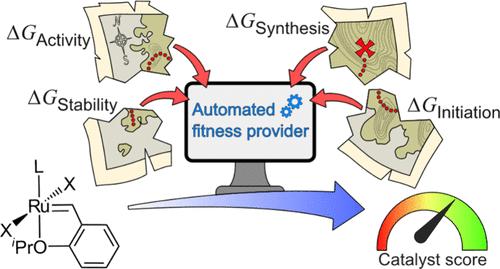Enabling Automation of de Novo Catalyst Design: An Experimentally Validated, Multifactor Design Metric for Olefin Metathesis
IF 11.3
1区 化学
Q1 CHEMISTRY, PHYSICAL
引用次数: 0
Abstract
Automated methods for molecular design navigate chemical space by ranking candidate compounds against predefined, numerical design metrics. To date, metrics for homogeneous catalysts focus on catalyst activity as the sole criterion, neglecting performance-critical factors such as stability and degradation. Here we introduce a general, multifactor design metric for molecular catalysts, and highlight the opportunities created by mechanistically-based de novo design by implementing this metric within the showcase application of olefin metathesis. Ruthenium-catalyzed olefin metathesis offers a prominent context within which the central importance of catalyst degradation is now widely acknowledged, and mechanistic understanding of the decomposition pathways has reached an advanced stage. A numerical figure of merit (or “fitness score”) for these catalysts is generated by combining functions based on DFT-calculated relative energies, which describe (i) catalyst initiation, (ii) catalyst activity in the metathesis of terminal olefins, (iii) catalyst stability–specifically, resistance to decomposition via β-hydride elimination, (iv) the synthetic accessibility of the precatalyst, and (v) its thermodynamic stability in the trans-anionic geometry essential for high activity. By comparing calculated fitness scores with catalytic turnovers measured in benchmark olefin metathesis reactions, we demonstrate that this multifactor fitness function reproduces the experimental ranking and productivity trend for catalysts known to exhibit profoundly different susceptibilities to decomposition. The trend cannot be reproduced by considering in isolation any of the individual factors, including catalytic activity or resistance to β-hydride elimination. The fitness formulation presented here establishes a foundation for automated screening and design of improved catalysts for olefin metathesis. More broadly, it establishes a general strategy for development of multifactor design metrics for molecular catalysts that incorporate mechanistic understanding of catalyst activity, stability, and synthetic accessibility.

实现新催化剂设计自动化:经实验验证的烯烃复分解多因素设计指标
分子设计的自动化方法根据预定义的数值设计指标对候选化合物进行排序,从而在化学空间中进行导航。迄今为止,均相催化剂的度量标准主要以催化剂活性为唯一标准,忽略了稳定性和降解等性能关键因素。在此,我们介绍了一种适用于分子催化剂的通用多因素设计指标,并通过在烯烃复分解的展示应用中实施该指标,强调了基于机理的从头设计所带来的机遇。钌催化的烯烃复分解反应提供了一个突出的背景,催化剂降解的核心重要性现已得到广泛认可,而对分解途径的机理理解也已进入高级阶段。通过将基于 DFT 计算的相对能量的函数进行组合,可以得出这些催化剂的优越性数值(或 "适应性得分"),这些函数描述了:(i) 催化剂的引发;(ii) 催化剂在末端烯烃偏析中的活性;(iii) 催化剂的稳定性--具体地说,通过β-酸酐消除分解的阻力;(iv) 前催化剂的合成可得性;以及 (v) 催化剂在高活性所必需的反式阴离子几何形状中的热力学稳定性。通过将计算出的适应性得分与在基准烯烃偏合成反应中测得的催化周转率进行比较,我们证明这种多因素适应性函数再现了实验排序和催化剂的生产率趋势,众所周知,催化剂表现出的分解敏感性存在很大差异。单独考虑任何一个因素,包括催化活性或对β-酸酐消除的抗性,都无法再现这种趋势。本文介绍的适应性配方为自动筛选和设计改良的烯烃偏析催化剂奠定了基础。更广泛地说,它为分子催化剂的多因子设计指标的开发确立了总体战略,这些指标结合了对催化剂活性、稳定性和合成可得性的机理理解。
本文章由计算机程序翻译,如有差异,请以英文原文为准。
求助全文
约1分钟内获得全文
求助全文
来源期刊

ACS Catalysis
CHEMISTRY, PHYSICAL-
CiteScore
20.80
自引率
6.20%
发文量
1253
审稿时长
1.5 months
期刊介绍:
ACS Catalysis is an esteemed journal that publishes original research in the fields of heterogeneous catalysis, molecular catalysis, and biocatalysis. It offers broad coverage across diverse areas such as life sciences, organometallics and synthesis, photochemistry and electrochemistry, drug discovery and synthesis, materials science, environmental protection, polymer discovery and synthesis, and energy and fuels.
The scope of the journal is to showcase innovative work in various aspects of catalysis. This includes new reactions and novel synthetic approaches utilizing known catalysts, the discovery or modification of new catalysts, elucidation of catalytic mechanisms through cutting-edge investigations, practical enhancements of existing processes, as well as conceptual advances in the field. Contributions to ACS Catalysis can encompass both experimental and theoretical research focused on catalytic molecules, macromolecules, and materials that exhibit catalytic turnover.
 求助内容:
求助内容: 应助结果提醒方式:
应助结果提醒方式:


